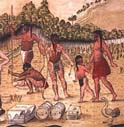
 |
| Illinois Indians visiting New Orleans, 1735. (colored pen and ink by Alexandre de Batz, 1735) enlarge |
The Illinois or Illiniwek Nation consisted of several independent American Indian tribes that spoke a common language, had similar ways of life, and shared a large territory in the central Mississippi River valley. The Illinois called themselves "inoca." French explorers and missionaries generally referred to them as "Illinois," but also used some other terms (Eriniouai, Liniouek, Aliniouek, Iliniouek, Ilinois, and Ilinoués).
According to Jacques Marquette, a Jesuit missionary who visited them in 1673, the word "Illinois" meant "the men." However, recent studies of the Illinois language indicate that "Illinois" may have instead come indirectly from the Illinois word "irenweewa," which means "he speaks in the ordinary way." Objibwa Indians of the eastern Great Lakes evidently borrowed this term from the Illinois and used it as a name for them, but in their language irenweewa became ilinwe. French explorers learned the name from the Ojibwa and spelled it "Ilinois" or "Illinois."
The name "Illiniwek" also appears to have come indirectly from the Illinois word "irenweewa" by way of the Ojibwa Indians. In the Ojibwa language, ilinwek is a plural form of ilinwe. Various spellings of ilinwek appear in the French literature, including "Liniouek," "Aliniouek," and "Iliniouek."
The term "Illini" has also been used to refer to the Illinois Indians. However, it does not appear to have any historical or linguistic validity.
In the late 1600s there may have been as many as 12 different Illinois tribes. However, by the end of the century seven of these tribes--including the Chepoussa, Chinkoa, Coiracoentanon, Espeminkia, Maroa, Moingwena, and Tapouaro--had disappeared or merged with other Illinois tribes. Five principal tribes survived into the 1700s: the Cahokia, Kaskaskia, Michigamea, Peoria, and Tamaroa. Only the Kaskaskia and Peoria continued to exist in the early 1800s.![]()
|
|
Copyright © 2000 Illinois State Museum